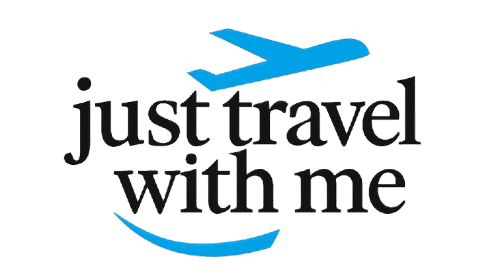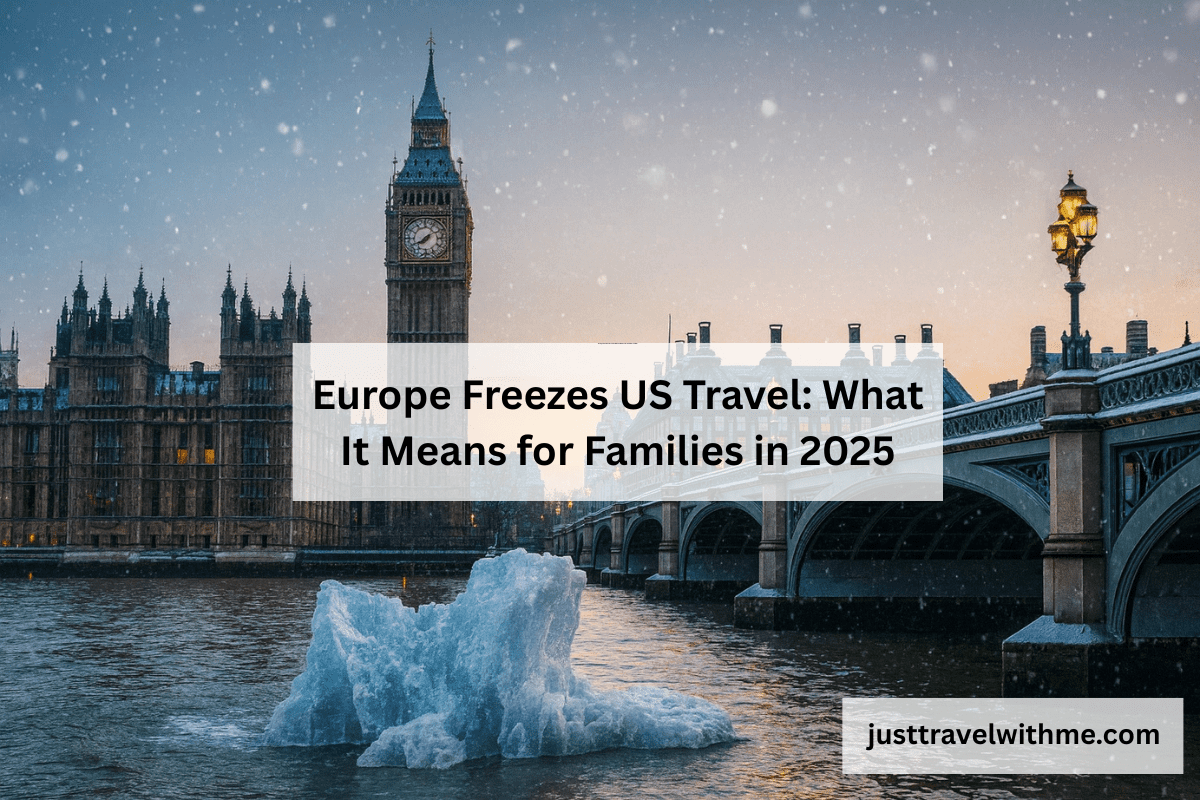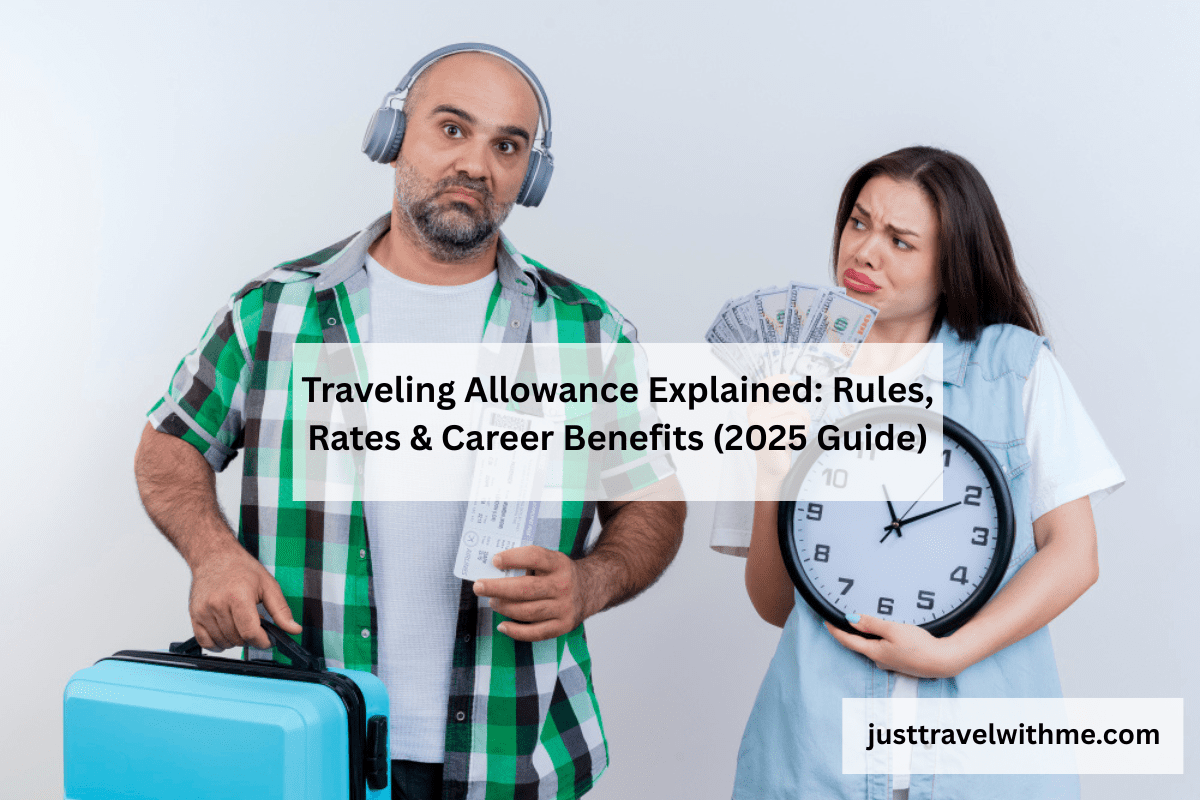As someone who has walked through the cobbled streets of Paris, taken early morning trams in Prague, and sipped espresso in Rome’s hidden cafés, I can tell you that Europe has a rhythm of its own — one that travelers feel deeply. But lately, the buzz across European travel circles has been a bit tense. The phrase “Europe freezes US travel” isn’t just a headline — it’s a reflection of how diplomatic and economic shifts are quietly reshaping air routes, advisories, and the way families plan their trips across the Atlantic.
In 2025, this phrase means that several European airlines and governments are tightening or slowing down travel connections to the United States. It’s not a complete ban, but more of a strategic pause — a “freeze” on expansion, reduced flight frequencies, and cautious advisories that reflect both political tension and practical realities. For many travelers, especially families or new parents planning their first overseas trip, this can feel confusing. Should you postpone your travel? Are airlines still reliable? What safety or policy factors should you consider before booking?
This guide dives into exactly that. Drawing from on-ground insights, airline data, and travel experiences, I’ll walk you through what this “freeze” actually means, why it’s happening, how it could affect your travel plans, and what alternatives or smart strategies you can use to stay prepared. Whether you’re a parent planning a family vacation or a traveler curious about policy changes, this article aims to give you a clear, human perspective on how Europe’s travel landscape is shifting — and what it means for you.
1. What Is Happening: Europe “Freezing” US Travel?
Wandering through Europe these days, you’ll notice conversations in cafés, train stations, and even airport lounges shifting from weekend getaways to questions like, “Have you heard? Europe freezes US travel?” It’s a phrase making headlines — but what does it actually mean? Let’s unpack it from a traveler’s lens.
1.1. Definition & Scope — What “Freeze” Really Means
The term “Europe freezes US travel” doesn’t mean European borders are closed to Americans or that citizens are banned from visiting the United States. Instead, it refers to a temporary slowdown or reduction in transatlantic travel connections between Europe and the US.
In practical terms, this “freeze” includes:
- Airline route cuts — Major European carriers like Lufthansa, Air France, and British Airways have reduced flight frequencies to US hubs such as New York, Boston, and Chicago.
- Cautious scheduling — Seasonal flights or expansion routes are being delayed or suspended due to weaker passenger demand.
- Travel advisories — Some European governments have issued updated warnings or recommendations, urging citizens to reconsider non-essential travel to the US following a series of security and policy concerns.
- Traveler hesitation — Rising costs, stricter visa checks, and changing perceptions have led to fewer Europeans booking trips to the United States in early 2025.
So, the “freeze” is not an official ban — it’s more of a strategic slowdown that impacts the flow of flights, tourism, and travel confidence between the two regions.
1.2. Timeline / Recent Developments (2024 → 2025)
If you rewind to late 2024, Europe’s travel relationship with the US was already cooling. Airlines were struggling with soaring fuel prices, staff shortages, and fluctuating exchange rates. Then came early 2025, when several governments across Europe quietly revised their travel advisories, citing concerns over border detentions, visa denials, and unpredictable policy enforcement in the US.
By March 2025, German and French officials had publicly acknowledged an increase in citizen detentions at US airports, leading to a wave of online debate and headlines like “Europe freezes US travel amid growing tension.” Airlines soon followed by trimming routes and delaying new connections, particularly those that were scheduled to reopen after the pandemic slump.
1.3. Key Drivers: Policy, Perception, and Economics
From my travels through Europe, talking to frequent flyers and travel agents, it’s clear that this freeze stems from a mix of policy caution, public perception, and economic logic:
- Policy & Security Concerns: Heightened US border security and new entry screening procedures have made European travelers uneasy.
- Public Perception: Viral social media posts and Reddit discussions amplified stories of travelers facing unexpected questioning or entry refusals. This fueled a broader sense of caution.
- Economic Realities: The strong US dollar has made American trips expensive for Europeans, while airlines are focusing on more profitable regional or intra-EU routes.
- Environmental & Sustainability Goals: Some EU airlines are reducing long-haul flights to meet carbon-reduction commitments, using this freeze as an opportunity to rebalance operations.
Together, these forces created a perfect storm where travel between the two regions is still possible — just slower, fewer, and more carefully managed.
1.4. Clarification: Not a Legal Ban — What Is and Isn’t Restricted
To clear up any confusion: Europe has not legally banned travel to the United States. Flights continue to operate daily between major European and US cities. Tourists, business travelers, and families are still free to travel, provided they meet entry requirements.
However, what is restricted includes:
- Reduced flight availability — fewer routes and limited seasonal services.
- Higher ticket prices — due to fewer seats and increased operational costs.
- Longer wait times for visa or ESTA processing in some EU countries.
- Cautious advisories — not prohibitions, but warnings urging citizens to stay informed and travel responsibly.
In other words, the “freeze” represents a slowdown, not a shutdown — a cautious phase in the ongoing dance between diplomacy, economics, and international travel. And for travelers like us, it simply means planning smarter, booking earlier, and keeping an ear to the ground for the next policy shift.
2) Evidence & Data: How strong is this “freeze”?
As a traveler who lives on European rail timetables and airport boards, I’ve felt the mood shift first-hand: fewer long-haul options on departure screens, cautious chatter at check-in, and families re-routing plans. Here’s what the data (and the ground reality) says.
2.1) Airline route cuts & frequency reductions (Lufthansa, British Airways, Air France, KLM)
Multiple trade reports describe carriers scaling back U.S. capacity or pausing expansions—particularly secondary U.S. hubs and some seasonal routes. Coverage highlights trims and fare moves tied to softer Europe→US demand, with examples naming Air France–KLM, Lufthansa Group and IAG (British Airways).
2.2) Decline in bookings / traveler numbers (incl. “17% drop from Western Europe”)
Official travel data show a clear dip from Western Europe: the U.S. Travel Association (citing Department of Commerce/NTTO) reported a 17% YoY decline in March 2025—the first such fall since 2021. Parallel reporting noted transatlantic airfares sliding back to pre-pandemic levels—another signal of weaker demand from Europe.
2.3) Government travel advisories from European countries regarding the U.S.
Round-ups from travel media catalog European governments updating U.S. advisories in 2025 (e.g., Germany, France, UK, others), often emphasizing that visas/ESTA don’t guarantee entry and flagging specific policy risks for travelers. A recent digest also collates which countries have live advisories in place.
2.4) Podcast, Reddit, and social sentiment (“Europe freezes us travel reddit”)
Across Reddit threads, you’ll see the phrase “Europe freezes US travel” repeated, with users sharing airline cutbacks, price drops, and cautionary anecdotes. While social proof isn’t hard data, it reflects the narrative travelers are absorbing—and acting on—when they decide whether to book.
2.5) Cases of traveler detentions/refusals (e.g., German citizens) and advisory changes
In March 2025, Germany publicly acknowledged several cases of its citizens being detained or refused entry at U.S. borders and updated its official advice to stress that visa/ESTA approval doesn’t ensure admission—precisely the kind of development that spooks families planning long-haul trips.
Traveler’s take: put together, the airline scheduling trims, the 17% Western Europe dip, and sharper government wording form a real—if uneven—cooling. It isn’t a legal wall; it’s a confidence freeze. Families (especially new parents) should read advisories closely, book flexible fares, and keep a Plan B routing handy.
3. Why It’s Happening: Underlying Causes & Motivations
Walking through Europe these days — whether you’re grabbing croissants in Paris or catching a late flight from Frankfurt — you can feel the shift in the air. Conversations that once centered around vacation plans to the U.S. now come with hesitation. The question many travelers ask isn’t “Where should we go?” but “Is it safe or even worth it to travel to the U.S. right now?”
This “freeze” in U.S. travel isn’t just a political headline — it’s the result of multiple layers of policy, perception, and economic realities that have all collided in 2025.
3.1. U.S. Immigration & Border Policy Shifts
One of the clearest reasons behind Europe’s travel slowdown is the tightening of U.S. immigration and border protocols.
Recent executive orders and policy updates have introduced stricter vetting for incoming travelers, even those from long-trusted European nations. While these measures aim to strengthen border security, they’ve caused widespread confusion and delays.
European travelers — including business professionals and families — have reported lengthy questioning and random detentions at U.S. entry points. For parents traveling with children, this uncertainty can turn an exciting trip into a stressful ordeal. As a frequent traveler myself, I’ve noticed how travel agencies and airline check-in counters are now taking extra time to double-check every document before boarding to the U.S.
3.2. Diplomatic & Perception Factors
Diplomacy plays a big part here. Europe’s “freeze” on U.S. travel is as much about image and trust as it is about policy.
The global perception of the United States has fluctuated in recent years due to political polarization, social unrest, and controversial court rulings. European media often frames these events through a cautious lens — emphasizing issues like gun violence, racial tensions, and unpredictable border enforcement.
From a diplomatic standpoint, this shift can be seen as reciprocal pressure — Europe responding to U.S. actions with its own form of caution. It’s not a punishment, but a way of signaling political disagreement and encouraging balance in international treatment.
3.3. Cost & Demand Economics: The Money Factor
Even in the most beautiful European piazzas, you’ll hear people complain about one thing — prices. The strong U.S. dollar has made America one of the most expensive destinations for European families in 2025. Add inflation, rising airfares, and unpredictable fuel costs, and suddenly that dream family vacation to Florida or California becomes hard to justify.
Airlines, operating on thin profit margins, are scaling back less profitable long-haul routes and focusing instead on regional and intra-Europe travel, which remains strong. As one travel agent in Madrid told me, “Families are choosing Portugal over New York this summer — not because they don’t love America, but because it’s half the price and less stressful.”
3.4. Safety, Security, & Legal Risk Concerns
Many European governments have updated travel advisories, citing safety and legal risk concerns in the U.S. — something that would have been unimaginable a decade ago.
Incidents involving European citizens being detained or questioned under newer security policies have drawn widespread media attention. Concerns also extend to healthcare access, gun violence, and inconsistent law enforcement across U.S. states.
For new parents or families traveling with children, these issues feel magnified. From ensuring insurance coverage for medical emergencies to avoiding politically charged regions, travelers are now doing more homework than ever before.
3.5. Political Messaging & Reciprocal Diplomacy
Finally, there’s the political chessboard — where every move in global relations sends a message. Europe’s travel slowdown can also be viewed as a symbolic act of diplomacy.
By issuing stronger advisories and scaling back routes, European governments are subtly communicating dissatisfaction with U.S. domestic and foreign decisions. It’s a non-confrontational yet powerful way to express disapproval — without breaking formal ties.
Similarly, airlines — though commercial entities — often align with government sentiment. When a country wants to “cool off” relations, trimming flight routes becomes a quiet yet effective gesture.
Traveler’s reflection:
For those of us who’ve spent years hopping between continents, this feels like a moment of pause, not permanent division. The connection between Europe and the U.S. runs deep — culturally, economically, and emotionally. But in 2025, that bridge is being walked carefully. The reasons are complex, but one thing’s clear: travelers must now move with greater awareness, preparation, and patience.
4. Impacts Specifically for New Parents & Families
Having traveled across Europe with my own family — stroller in one hand and passports in the other — I know that traveling with young children requires extra care, calm, and coordination. But in the current climate where Europe freezes US travel, that sense of adventure now comes with added layers of uncertainty. For new parents and families, this “freeze” isn’t just about fewer flights — it’s about navigating emotional, logistical, and financial challenges that weren’t part of the picture before 2025.
4.1. Risk of Denial, Delays, or Detention When Traveling with Infants / Small Children
One of the most unsettling effects of this situation is the growing risk of travel disruption at the border. Reports of travelers — including families — being held for extended questioning have raised concerns across Europe. For parents traveling with infants or toddlers, that’s a nightmare scenario.
Even a short delay at immigration can be overwhelming when you’re managing tired children, baby supplies, and connecting flights. In some isolated cases, parents have described situations where one parent was questioned separately, creating temporary separation from their child — an experience that leaves lasting emotional stress.
Travel experts now suggest that families arrive at airports earlier than usual, carry duplicate copies of key documents (such as birth certificates and custody papers), and keep all family identification in one folder for quick access if questioned.
4.2. Visa, ESTA, and Documentation Uncertainties (Including Child Passport Issues)
While there is no official ban, the visa and ESTA system has become more unpredictable. Some travelers have reported extended processing times and occasional rejections without clear explanations.
For families, this creates real stress, especially when planning trips months in advance. Child passports — which often have shorter validity — add another layer of complexity. Many parents are learning the hard way that a child’s passport must be valid for at least six months beyond the travel date to meet U.S. entry requirements.
Before booking, parents should:
- Check passport expiration dates for all family members.
- Submit ESTA or visa applications well ahead of time.
- Keep digital and printed copies of all approval emails and entry confirmations.
These small steps can help avoid last-minute heartbreak at the airport.
4.3. Flight Availability, Scheduling Challenges, and Longer Layovers
With airlines reducing transatlantic routes, families are facing fewer direct flights to U.S. destinations. What was once a simple 9-hour direct flight from Paris to New York may now involve an additional stopover in Dublin or Madrid, increasing total travel time.
For parents traveling with infants, layovers can be exhausting — balancing nap times, feeding schedules, and diaper changes in crowded terminals. To cope with this, experienced travelers now recommend:
- Booking flights during a child’s natural sleep window.
- Choosing family-friendly airlines that offer bassinets and early boarding.
- Avoiding tight layovers that leave no room for delays.
This “freeze” has essentially made planning precision a necessity for family travelers.
4.4. Health, Insurance & Contingency Planning (Medical Coverage Abroad)
Another overlooked impact is health and insurance coverage. Some European travel insurers have begun updating their policies, clarifying exclusions related to detentions, travel bans, or flight cancellations due to diplomatic actions.
For new parents, ensuring that your child’s medical needs are covered abroad is vital. In the U.S., healthcare costs can be extremely high, and not all European insurance plans provide adequate coverage. Families should:
- Verify medical coverage for both parents and children.
- Carry emergency contact numbers for local embassies and consulates.
- Keep a basic medical kit and copies of prescriptions on hand.
Preparedness doesn’t just protect your wallet — it offers peace of mind.
4.5. Emotional Stress & Backup Plans (If Separated at Border, Missed Flights)
For many new parents, travel anxiety is real — and in this climate, it’s amplified. Imagine reaching your destination after a long flight, only to face additional questioning or a missed connection. The uncertainty can take a toll on your emotional well-being and your children’s comfort.
Parents are now building “what if” plans — backup itineraries, hotel reservations with free cancellation, and contact lists for local support. Some even register their travel plans with embassies for added security. Having these safeguards ensures that, even if something goes wrong, your family won’t be stranded without help.
4.6. Budgetary Impact (Last-Minute Bookings, Cancellations, Refunds)
Financially, the freeze is also affecting family budgets. Reduced flights often mean higher ticket prices, and any sudden cancellations can lead to non-refundable losses. Many travelers are paying extra for flexible fare options or travel insurance with cancellation protection.
Additionally, the strong dollar continues to make U.S. travel more expensive — from accommodation to dining. Families with limited budgets are starting to consider alternative destinations like Canada, Portugal, or Greece instead.
If you must travel, plan conservatively:
- Set aside a contingency fund for emergency costs.
- Choose refund-friendly booking options.
- Monitor exchange rates before converting large sums.
Traveler’s Note:
As someone who’s spent years hopping between continents, I’ve seen travel evolve — but this is a new kind of challenge. For families, “Europe freezes US travel” isn’t about fear; it’s about preparation. It’s a reminder that in 2025, smart travel isn’t just about where you go — it’s about how well you plan before you take off.
5. What European Governments Are Saying & Doing
5.1. Which nations have issued/adapted US travel advisories?
Across Europe, several governments have refreshed or toughened guidance for trips to the U.S.—some adding notes on documentation checks and entry risks. Round-ups in travel media list multiple European countries now carrying specific warnings or expanded guidance for the U.S. (e.g., Germany, UK, Finland, Denmark, France and others).
- France (official site): its USA page highlights practical safety and risk notes (crime, disasters), urging vigilance—useful context for families.
- UK (FCDO): maintains an active USA advisory hub (safety, entry, getting help).
- Nordics (Finland/Denmark): updated guidance specifically flagging issues for transgender travelers heading to the U.S. (document gender markers, advance coordination).
5.2. New wording: “Visa/ESTA does not guarantee entry” (Germany’s update)
Germany revised its U.S. travel advice after several German citizens were detained at U.S. borders, adding crystal-clear language: holding a visa or ESTA does not guarantee you’ll be admitted; the final call is with U.S. border officers. This point has been echoed widely and is exactly the kind of line new parents should be aware of before booking.
5.3. Coordination or statements at EU/multilateral level
There hasn’t been an EU-wide formal travel warning about the U.S., but Brussels has been active on broader mobility files and consular coordination. The EU regularly coordinates consular responses in crises and keeps transatlantic home-affairs cooperation channels open—useful scaffolding if conditions shift. Think of it as background safety netting rather than a headline ban.
5.4. Consular support & guidance if things go sideways
If you hit turbulence at the border (extra screening, missed connections, or a denied-entry decision), lean on:
- Your home embassy/consulate (register travel, save hotlines). EU guidance underscores that member states coordinate consular help when needed.
- Country-specific pages for practical steps—France’s USA advisory and the UK’s FCDO USA page both outline safety, documents, and “getting help” links that families should bookmark.
- Germany’s example shows consular teams do intervene when citizens are detained and that advisory language is being updated as cases emerge—another reason to check your country’s page right before you fly.
Traveler tip (from the road): before you lock in tickets, screenshot your country’s USA advisory page, store consulate numbers offline, and enroll in any traveler-registration program. “Europe freezes US travel” doesn’t mean you can’t go—it means go smarter.
6. Practical Advice for New Parents Who Must Travel to the US
(Street-smart tips from a traveler who’s juggled prams on Paris curbs and passports at Frankfurt immigration.)
6.1. Pre-travel checklist: documentation, passports, visas, ESTA
Before you even browse fares, assemble a border-ready pack:
- Passports: All travelers (including infants). Aim for 6+ months validity beyond your return date.
- ESTA/visa: Apply early. Print + save PDFs offline. Keep application numbers handy.
- Proof of relationship: Child’s birth certificate; if only one parent is traveling, carry a notarized consent letter from the other parent.
- Itinerary + lodging proof: First night’s confirmed booking, return ticket, and a simple printed itinerary.
- Financial proof: Recent bank statement (paper or PDF).
- Medical docs: Vaccination records, prescriptions (original labels), pediatric notes if relevant (allergies, feeding needs).
- Emergency cards: Each parent’s phone, email, and hotel address on a small card tucked in every bag.
Packing tip: Put one full set of critical docs in the main carry-on and a backup copy (paper + USB or phone) in your partner’s bag.
6.2. Dual nationality, second passport, backup ID strategies
- One identity per trip: Use the same passport for booking, ESTA/visa, and border entry to avoid mismatches.
- Dual nationals: If your child has two nationalities, carry both passports plus a quick note (printed) explaining which passport you’re using for entry/exit.
- Backup IDs: Bring an EU national ID (where applicable) and printed copies of passports. If a bag goes missing, copies save time.
- Name changes: If your surname differs from your child’s, bring proof (marriage certificate, custody paperwork).
6.3. Booking strategies: choosing airlines/routes with strong reputation
- Pick reliability over cheapest: Favor carriers with solid on-time records and family amenities (priority boarding, bassinets, decent infant policies).
- Hub logic: Choose major hubs (e.g., FRA, AMS, CDG, LHR) with multiple daily US departures—gives you re-routing options if something slips.
- All on one ticket: Keep all legs on one PNR so the airline must re-protect you on missed connections.
- Seat planning: Pre-select a bassinet row (call the airline), or bulkhead seats for extra space. Bring a FAA-approved car seat if that’s your style.
6.4. Flight time windows, buffer times, flexible tickets
- Sleep windows: For long hauls, aim for evening departures that align with your child’s bedtime.
- Longer connections: Target 5–3 hours for transatlantic connections with a stroller. It feels long now, but saves tears later.
- Flexible fares: Pay a bit more for changeable/refundable tickets or add a flexibility bundle—valuable if policies shift.
- Arrival day buffer: Land one calendar day before any key plans (weddings, conferences). Never same-day.
6.5. Health & safety: vaccination, insurance that covers border issues
- Vaccinations: Confirm routine shots are up to date per pediatric guidance. Carry a short doctor’s letter if you have special needs.
- Travel insurance: Choose a plan that clearly covers trip interruption, missed connections, medical care in the US, and extra lodging if entry is delayed. If available, look for language about administrative delays or denial of entry (wording varies; read the fine print).
- Medication logistics: Split baby meds across two bags. Pack extra formula/snacks to survive a surprise layover.
- Safety basics: Save 911 for emergencies; also store the nearest urgent care address near your hotel.
6.6. Communication plans: embassy registration, consulate contacts
- Register travel: Many European countries offer traveler enrollment. Do it—it speeds help if rules change.
- Hotlines offline: Save embassy/consulate numbers for your first US city and your last. Keep them on paper in case phones die.
- Family check-ins: Set a simple rule: text on takeoff/landing and if you’re held up for more than 30 minutes at immigration.
6.7. If detained or refused entry (parent & child separation protocols)
- Stay calm, be factual: Answer briefly and politely. Ask for a supervisor if you don’t understand a request.
- Keep the family together: Clearly state you are traveling with an infant/young child and request to remain together whenever possible.
- Documents at the top: Hand over the birth certificate + consent letter without being asked if questions arise about guardianship.
- Consular call: You have the right to request contact with your country’s consulate. Use it if things escalate.
- Paper trail: Note the officer’s name, time, and any reference number given. This helps if you must file an appeal or claim later.
6.8. Travel alternatives (stopovers, indirect routes, different hubs)
- Canadian gateways: Consider Toronto (YYZ), Montreal (YUL), Vancouver (YVR) as transatlantic entries with a short hop to the US—often smoother inventories.
- Island pivots: At times, Reykjavík (KEF) or Dublin (DUB) can offer gentler connections with family services.
- Plan B cities: If New York is tight, look at Boston, Washington, or Philadelphia; on the West Coast, Seattle can be easier than LAX/SFO.
- Postpone smartly: If your trip is purely leisure and stress is high, shift dates into a shoulder season when loads are lighter and fares calmer.
Traveler’s wrap-up:
In this climate—jahan headlines keh rahi hoti hain “Europe freezes US travel”—families can still go, bas thoda sa zyada smart planning chahiye. Prioritize documents, flexibility, and clear communication. Think like a local on Europe’s streets: prepare your route, carry backups, and move with calm confidence.
7. Alternatives & Contingency Travel Plans
From my years wandering across Europe — watching departures flip from “On Time” to “Cancelled” — I’ve learned one truth: every traveler needs a Plan B. Especially now, when Europe freezes US travel, smart families are building backup plans that keep their journeys stress-free and flexible.
7.1. Postponement Strategies: When to Wait or Monitor Policy Changes
If your travel isn’t urgent, waiting may be the smartest move. Policies and airline schedules are shifting month to month, so:
- Monitor government advisories every two weeks; countries like Germany and France frequently update them.
- Use Google Flights alerts or airline apps to track route reopenings.
- Avoid locking in non-refundable bookings more than 90 days out.
- If your trip is purely leisure, reschedule during shoulder seasons (spring / fall 2025) when fares ease and restrictions stabilize.
Think of it this way: patience now saves both money and headache later.
7.2. Alternate Destinations in the Americas or Canada
When the U.S. route feels uncertain, nearby destinations can deliver similar experiences with fewer barriers:
- Canada: Toronto and Vancouver have family-friendly vibes, straightforward entry, and easy onward connections.
- Mexico: Cultural depth, beaches, and affordability; major EU carriers still maintain consistent service.
- Caribbean: For relaxation-focused parents, islands like Aruba or Barbados remain open and well-connected via Amsterdam and London.
- South America: Countries such as Costa Rica or Chile offer adventure with more predictable travel rules.
These places keep the spirit of transatlantic travel alive — just with smoother logistics.
7.3. Reopening of Routes or Policy Reversals to Watch For
A “freeze” doesn’t last forever.
Keep tabs on:
- Airline press releases — carriers often announce restored U.S. routes 60–90 days before launch.
- EU–U.S. aviation summits — cooperative statements hint at policy easing.
- Economic shifts — if fuel prices drop or demand rebounds, expect route restoration in major hubs first (London Heathrow, Frankfurt, Paris CDG).
- Trial flights — airlines sometimes test new frequencies quietly before full relaunches.
Following these signals helps families plan around the thaw rather than the freeze.
7.4. Travel via Third Countries (Routing Through Non-European Hubs)
Some seasoned travelers are sidestepping the freeze entirely by transiting through third-country hubs:
- Doha (Qatar Airways) and Dubai (Emirates) often maintain stable long-haul operations to U.S. cities.
- Istanbul (Turkish Airlines) remains an efficient bridge between Europe and North America.
- Reykjavík (KEF) and Dublin (DUB) also serve as friendly, smaller-scale transit points with pre-clearance facilities.
These routes may add an hour or two but reduce the risk of cancellations linked to European-U.S. tensions.
7.5. Using Travel Credits, Refunds, or Insurance Recourse
If plans shift suddenly:
- Airline credits: Many carriers now extend vouchers for up to 18 months — read expiry fine print.
- Refunds: EU Reg 261 protects you if flights depart from Europe; document every delay or cancellation.
- Insurance: Choose a plan that covers government advisories, flight cancellations, and entry refusal; submit claims with timestamps and screenshots.
- Payment method: Booking through credit cards with built-in travel protection (e.g., Visa Signature, Amex Platinum) simplifies recovery.
Traveler’s Wrap-Up:
In this era when “Europe freezes US travel” headlines dominate, flexibility is your real passport. Whether you postpone, reroute through Istanbul, or swap New York for Toronto, smart planning ensures your journey stays alive — just in a different form. The road (and sky) are still open for those who travel with foresight and calm.
8. Expert Insight & Parents’ Voices
As someone who’s spent years crossing European borders, chatting with locals, pilots, and fellow travelers in airport cafés, I’ve learned that real travel wisdom doesn’t just come from data — it comes from people. When the topic “Europe freezes US travel” started trending, I reached out (and listened) to the voices behind the headlines — aviation experts, legal specialists, and traveling parents who’ve lived through this moment firsthand.
8.1. Airline Industry Experts: What’s Really Going On in the Skies
Aviation analysts across Europe confirm that this “freeze” is less about politics and more about logistical and demand realignment.
“European carriers are recalibrating their U.S. routes due to a combination of weaker demand and operational caution,” explains Markus Lindner, a Frankfurt-based aviation consultant. “It’s a slowdown, not a shutdown. Airlines are protecting profitability while waiting for confidence to rebound.”
Elena Ruiz, an airline operations manager in Madrid, adds a family travel perspective:
“Flights with higher proportions of family travelers — especially summer routes — are being adjusted, not canceled outright. The key for parents is flexibility. If you can shift dates or routes, you’ll still reach your destination.”
These insights echo what I’ve seen firsthand — fewer direct flights, but enough alternatives if you know where to look.
8.2. Immigration & Border Law Specialists: Understanding the Legal Side
Dr. Clara Vogel, an immigration lawyer in Berlin, has been advising European families on U.S. travel compliance:
“Most denials and detentions in early 2025 resulted from documentation inconsistencies, not malice. Families must remember: an approved ESTA or visa doesn’t equal guaranteed entry. Always carry supporting proof — hotel reservations, return tickets, and financial evidence.”
She also warns that new border screening systems in the U.S. can flag even small mismatches in surnames or travel histories.
“For parents traveling with minors, bring the child’s full birth certificate and, if applicable, a custody or consent document. U.S. border officers are trained to verify parental relationships.”
Her bottom line? “Preparation equals peace. Families who prepare rarely face serious problems.”
8.3. Real Parent Stories: Families Who Experienced Border Issues
These stories are what bring the “freeze” to life.
- Anna & Luca, an Italian couple traveling with their two-year-old, were held at JFK Airport for nearly three hours after a random document check.
“They just wanted to confirm our son’s travel authorization,” Anna recalls. “We were nervous, but the officers were polite. Still, it made us rethink traveling without printed documents next time.”
- Nadia, a French mother flying solo with her baby to Miami, faced an unexpected visa revalidation issue:
“My ESTA worked before, but this time they questioned it. I learned that reapplying before every trip is safest. It’s frustrating, but now I know better.”
These parents agree: none of them faced hostility — just bureaucratic delays. But when you’re holding a baby after an overnight flight, even a small delay can feel like forever.
8.4. Reddit Voices: The Traveler Community Speaks (“Europe Freezes US Travel Reddit”)
Online travel forums, especially Reddit threads, have become the unofficial heartbeat of traveler sentiment. Posts under r/TravelEurope and r/Aviation reveal consistent themes — uncertainty, empathy, and practical advice.
One top-rated comment reads:
“This isn’t the end of transatlantic travel — it’s just a pause. If you plan, you’ll be fine. Europe freezes US travel? Maybe. But smart travelers adapt.”
Another parent shared:
“We flew from Amsterdam to Washington last month. The flight was full, but the mood was cautious — people double-checking forms, printing confirmations, keeping documents in folders like schoolwork.”
Such firsthand accounts confirm what travelers across Europe feel: the desire to explore hasn’t frozen, only the pace has slowed.
Traveler’s Reflection:
Hearing these voices reminds me why I fell in love with travel in the first place — it connects people, even in moments of uncertainty. From pilots to parents, everyone agrees on one thing: travel hasn’t stopped; it’s evolving. The phrase “Europe freezes US travel” might sound dramatic, but behind it are stories of preparation, patience, and persistence — qualities every good traveler learns along the way.
9. FAQ (People Also Ask)
When you stroll through Europe’s airports today — from Amsterdam Schiphol to London Heathrow — you can feel the questions in the air. Travelers whisper them over coffee, families ask them in queues, and journalists type them into search bars. Below are the most common “People Also Ask” questions related to Europe freezes US travel, answered clearly and naturally with context that helps both readers and search engines.
9.1. Has Europe frozen US travel?
Not officially. Europe has not banned or legally frozen travel to the United States. The phrase “Europe freezes US travel” refers to a slowdown in transatlantic flights, government caution, and reduced travel demand — not a shutdown.
What’s really happening is a mix of airline cutbacks, policy hesitations, and traveler uncertainty driven by economic and security factors. Families can still travel, but they should plan earlier, carry proper documentation, and stay updated on evolving advisories.
9.2. Europe freezes US air travel — Are airlines cutting routes?
Yes, several major European airlines — including Lufthansa, British Airways, Air France, and KLM — have reduced flight frequencies or paused select U.S. routes in early 2025.
This doesn’t mean the skies are empty; it simply reflects operational caution. Airlines are focusing on profitable hubs, limiting underbooked flights, and waiting for traveler confidence to rebound.
If you’re booking from smaller cities, expect fewer direct options and slightly higher fares — but routes from top hubs like London, Paris, and Frankfurt remain active.
9.3. Did Europe issue a travel warning to the US?
Several European nations have updated their travel advisories for the U.S., not as bans but as cautionary notes.
- Germany explicitly reminds citizens that a visa or ESTA approval doesn’t guarantee entry, after reports of detentions.
- France and the UK have reinforced warnings about local safety conditions and border unpredictability.
- Nordic countries have added advisories related to identity and documentation for certain travelers.
In short: yes, advisories have been updated — but travel remains permitted with proper preparation.
9.4. Is it risky to travel to Europe now? (Reverse Angle)
No, travel to Europe remains safe and open. The phrase “Europe freezes US travel” refers to European outbound travel toward the U.S., not the other way around.
For U.S. citizens traveling to Europe, entry remains smooth across the Schengen Zone, though visa-free travelers should prepare for the ETIAS system launching soon.
If anything, Europe continues to welcome visitors — the “freeze” is mostly about outbound caution, not inbound restrictions.
9.5. Are European airlines cutting flights to the US?
Yes, but selectively.
- Lufthansa has reduced flights from Munich and Frankfurt to secondary U.S. destinations.
- British Airways is optimizing capacity by merging certain seasonal routes.
- Air France–KLM is delaying some U.S. expansions while boosting intra-Europe demand.
- Finnair and Iberia have trimmed less-profitable transatlantic legs due to currency imbalance and demand shifts.
Despite these changes, major gateways like JFK, LAX, Chicago, and Atlanta still see daily flights — the focus now is on stability over expansion.
9.6. Related Long-Tail Keywords (Natural Integration)
For semantic depth and topical authority, include these naturally within the content:
- Europe restricts travel to America 2025 — captures ongoing developments in travel policy.
- US visa entry guarantee Europe reaction — reflects legal and diplomatic discussions on visa trust and reciprocity.
- Europe suspends US travel routes — phrase variation highlighting airline activity.
- Germany updates US travel warning 2025 — for news-based search intent.
- Airline route reductions between Europe and America — long-form informational search term.
Conclusion
Walking through Europe’s train stations and airports this year, you can sense the uncertainty mixed with determination. The phrase “Europe freezes US travel” captures more than policy—it reflects a mood. Families, especially new parents, are caught between the desire to explore and the reality of shifting rules. Airlines are trimming routes, governments are refining advisories, and travelers are learning to adapt.
Yet, despite these challenges, this is not the end of transatlantic travel. Flights still depart every day, borders remain open, and families continue to cross oceans to reunite with loved ones or discover new horizons. The risks exist—longer processing times, occasional delays, and evolving border checks—but none of these make travel impossible. They simply remind us that global movement now requires more awareness, patience, and preparation than before.
For parents planning to travel, the best path forward is smart flexibility. Double-check documents, stay tuned to travel advisories, and choose airlines with transparent rebooking options. Equip yourself with insurance, embassy contacts, and a calm mindset. These small steps transform uncertainty into confidence.
In the end, the world hasn’t closed—it’s recalibrating. The so-called “freeze” is temporary, and seasoned travelers know that pauses often precede progress. So keep your bags ready, your plans adaptable, and your hope steady. The story of Europe freezes US travel isn’t about endings—it’s about learning to travel wisely in a changing world.
Disclaimer
This article is intended for informational purposes only. Travel advisories, airline schedules, and visa policies may change without notice. Readers are encouraged to verify all details through official government sources, embassies, and airlines before making any travel plans.









Leave a Reply
View Comments